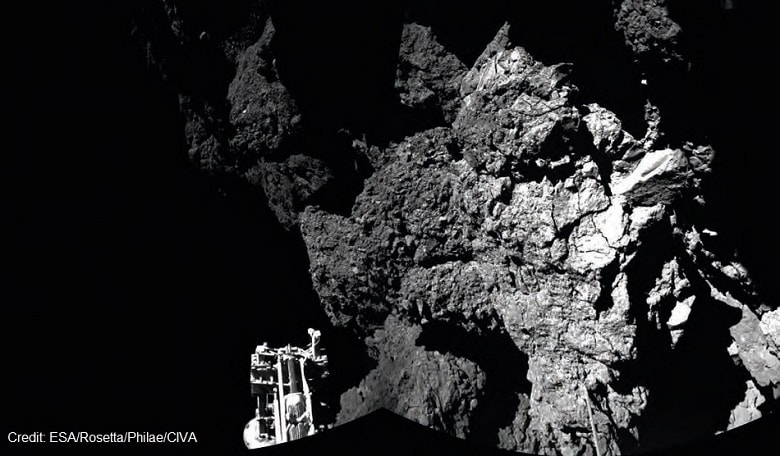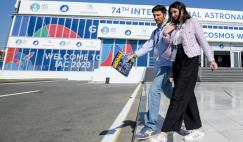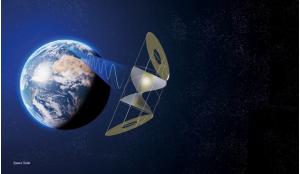The date 12 November 2014 will be remembered as the day when Europe made space history by making the first landing of a robotic probe on a comet. Anticipation of the event and the challenges to success had already raised worldwide attention, but the unexpected bouncing upon touchdown led to even larger worldwide interest.
The engineering efforts to make this attempt a success date back to the mid-90s, when Philae’s study and design phase began. In particular the landing gear had to be designed in a way that would allow it to cope with a range of comet surfaces. As the problem of rebounding upon touchdown was a known risk, two separate systems were developed to mitigate this.
First, Philae was equipped with a pair of harpoons that would shoot into the comet upon touchdown. Second, in order to counteract the equal but opposite force the harpoons would exert when fired, a thruster was integrated that would provide a push towards the comet’s surface.
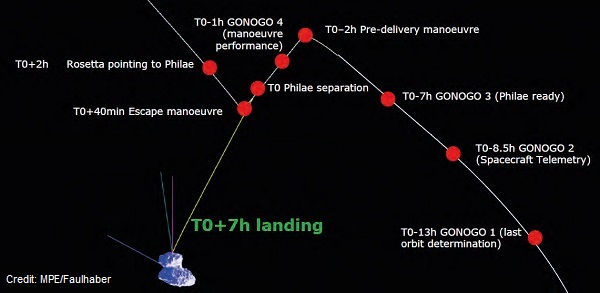 Rosetta’s trajectory and decision points prior to separation.
Rosetta’s trajectory and decision points prior to separation.
The trouble was that these were both ‘one-shotonly’ systems and so could not be test fired during the 12-year-long cruise to reach the comet. These systems and their inherent untestability proved to be vital ingredients to an already challenging comet landing.
Preparations
November 12, 2014 will be remembered as the day when Europe made space history…
Although the comet landing occurred on 12 November, Philae was switched on in preparation during the late afternoon of 10 November 10. This was necessary to allow for a 24 hour heating phase to warm up Philae to the required temperatures. Following this we started conducting the critical activities in preparation for the separation and landing phases.
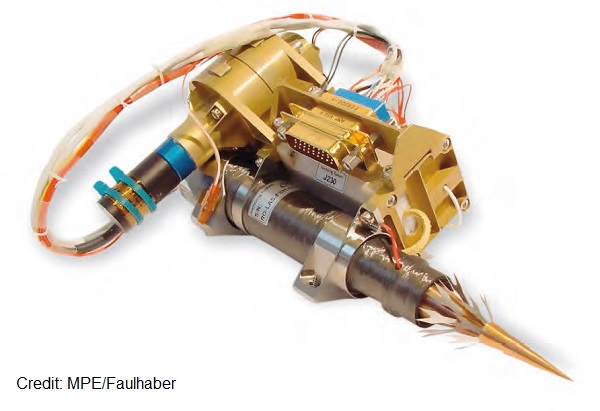 One of the critical Philae harpoons.
One of the critical Philae harpoons.
Prior to this switch-on Philae had already been powered up a total of 77 times without any problem, yet this 78th switch-on did not go smoothly and after 10 minutes communication with Philae was lost. This immediately changed a “relaxing” 24 hour heating phase into a stressful day of failure investigation. Together with the operations team at ESA’s ESOC in Darmstadt, Germany, we concluded that commanding the lander to switch-off and on again was the only effective solution. Fortunately it worked and the heating phase continued as planned.
These unexpected troubles led to a first night of little sleep and emergency teleconferences with Rosetta’s management. In particular, another scheduled reboot of Philae was planned the evening prior to the landing and doubts were raised if this should be attempted at this point.
There was more bad news on the evening prior to the landing when the thruster’s gas tank was opened. The thrust is controlled through a valve, however, to prevent any unwanted gas escape because of a valve failure during cruise an additional membrane had been used to hermetically seal the tank. To prepare the thruster this membrane had to be opened, releasing the gas into the pipes leading to the closed valve. Sensors monitor the pressure in the tank and in the pipe. After opening, the pipe pressure should raise to equal the tank pressure. Unfortunately, this did this not happen. As only a single pipe pressure sensor was installed, a sensor failure could not be excluded. In any case the activity was repeated, with the same results.
Some good news came soon after, however, when the planned reboot of Philae was successful and no anomalies were observed. What a relief.
Despite having no pressure in the thruster, the Lander team provided our “GO for separation” to ESA. This meant were ready to proceed with the next step in the landing timeline, the execution of the delivery orbit manoeuvre. It took place perfectly, placing Rosetta and Philae on the right path towards separation.
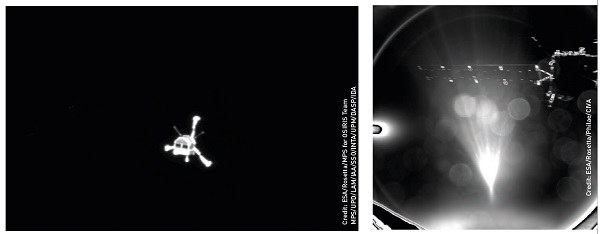 The farewell image taken by Philae of Rosetta seconds after separation.
Left: Philae imaged by Rosetta’s OSIRIS camera during the descent to the comet surface. This confirmed that the landing gear had unfolded.
The farewell image taken by Philae of Rosetta seconds after separation.
Left: Philae imaged by Rosetta’s OSIRIS camera during the descent to the comet surface. This confirmed that the landing gear had unfolded.
Whilst attached to Rosetta, Philae continuously communicated with Rosetta, which forwarded the Philae data to Earth. Upon the instant of separation this umbilical connection was interrupted. Philae and Rosetta had to re-establish communication through their respective antennas. To ‘see’ the lander, Rosetta had to manoeuvre after separation, this meant a communication outage of approximately 2 hours following separation.
In that time Philae was supposed to open its landing gear. If this didn’t happen, the landing would be a disaster. So there were two hours of total suspense until the message came “we have a link!”
Philae’s data was transferred to Rosetta and forwarded to Earth immediately. It showed us that the separation and subsequent activities had all gone flawlessly. However, the big question that remained was did the landing gear unfold properly? Philae has no sensors to reveal this information, therefore we remained in suspense until an image was received from Rosetta’s OSIRIS camera showing Philae on its way to the comet surface. For me, this was the moment of great relief, seeing that after 12 years of interplanetary space travel Philae was ready to set foot on the comet.The operations team could now lean back just a little as what remained was to monitor the ongoing operations and wait for the touchdown window to open.
When the moment for which we had been preparing for so many years finally came, communication between Philae and Rosetta was continuous and stable. We were all looking at our screens and waiting for that message to come.
In parallel, my mind was going through all the possible scenarios that could occur: what if communication drops upon touchdown? Would this mean that we tipped over? Or perhaps we rebooted due an electrostatic discharge? Or something else that I forgot to think of?
Then the signal came and there was a flood of information. Everything was happening at one: the touchdown signal, harpoon firing, commanding the thruster, switching off the flywheel, changing unit modes, normal telemetry, scientific data. One question occurred immediately: did the harpoons actually fire? They were the key to the landing securing itself to the surface.
Interpreting all the information was not trivial and so many people are involved that things became distracting. People were speaking on the voiceloop, arms were going up in triumph and celebrations were beginning. I was left thinking, ‘Did I miss something? Why does there seem to be something that isn’t right?’
…the signal came and there was a flood of information. Everything was happening at one…
Within minutes the experts responsible for the harpoons came back with the information that they didn’t fire; the statement on successful harpoon firing was not correct. By now other questions were forming in people’s minds: why do we also still see a rotation of Philae? We had this rotation during the descent, we could clearly see it because the solar panels were being illuminated one after the other, but why do we still see it? Philae is supposed to be stationary on the surface of the comet yet it was still rotating.
The rotation was less regular now though and in addition the communication link between Philae and Rosetta wasn’t stable anymore. Within minutes the picture became clear: we had rebounded from the surface.
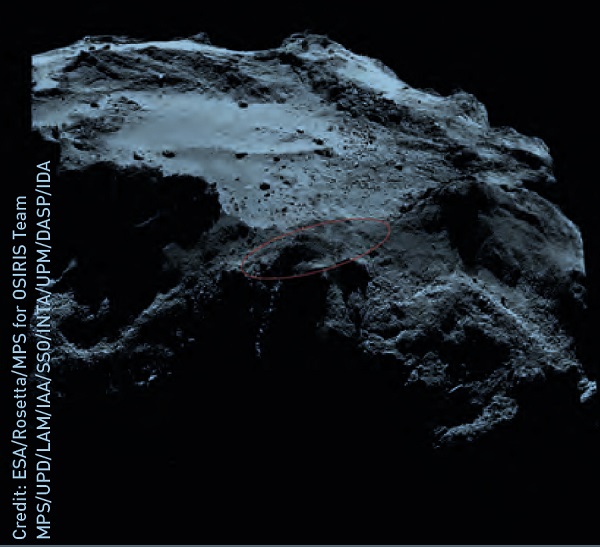 Philae search area derived from landing reconstruction.
Philae search area derived from landing reconstruction.
The television screen at the Lander Control Center were showing people at ESOC celebrating. Yet we were not. The spectators here in Cologne were looking from the screen to us, puzzled at the different reactions. The PR responsible was firing questions at us: “did we land or not?!” Well we did land, but we also took off again.
We had to focus on the essentials now: what do we know? what will happen next? We gathered some key engineers together and went through the situation: we knew we had touched down some 20 minutes ago, the harpoons did not fire and we didn’t know why, the thruster failed to thrust, there is still communication between Philae and Rosetta albeit less stable, the on-board computer is functioning nominally and is executing the posttouchdown activities.
It’s now clear to everyone: we rebounded with an unknown velocity away from the comet surface and we have no way to tell how high/far we are bouncing nor if and when we will come back down again. There is nothing we can do.
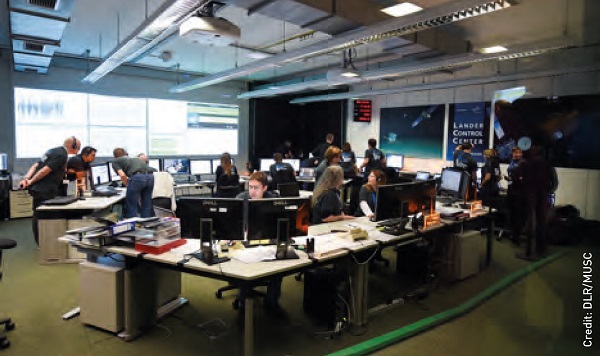 The DLR LCC Operations Team analysing and discussing the available data during the bounce.
The DLR LCC Operations Team analysing and discussing the available data during the bounce.
Minute after minute we monitored the communication link status and the rotation; one of these had to change at some point. We would either loose the communication as Philae left Rosetta’s field of view or the rotation would change because we touched the comet surface again. To everyone’s relief the latter occurred. The solar panel data became stable. That meant we had stopped rotating and we still had communication; this was the comet landing we were waiting for, 2 hours after the first touch-down.
First night on the comet
Some 30 minutes after this final landing, communication was lost, the communication experts quickly clarified that this was because Philae had disappeared over the horizon. The main issue to clarify now was where we landed, if and when communication would come back, and how this new landing site was going to impact our mission.
The engineering teams at DLR, ESA and CNES, together with all the science teams started to look at all available data and during the course of the night, the details of the bounce became clearer. We were also positive that communication would come back again about 12 hours after it was lost, although we were not entirely sure at what time.
Following a nominal landing we would have started with the drilling activities, but everyone agreed that this was now too risky. We first needed images to understand our position. With this decision made, it was finally time to get some sleep.
After only a few hours of sleep the phone rang with the message: “Philae’s back!”. We got the first images taken by the probe and they were astonishing. It was immediately clear that Philae was not sitting upright on smooth terrain and that this was going to have consequences for the predefined science timeline. Fortunately all teams were located at DLR in Cologne, thus communication loops were short and efficient and what followed was a rollercoaster of rescheduling the science activities, updating the battery lifetime predictions and hoping for the next communication link.
It was soon clear that there was not enough light falling on Philae to charge its secondary batteries. This meant that after the 46 or so hours of the primary battery’s life, Philae would go to sleep. The later a science measurement was scheduled, the higher the risk that the batteries would not last long enough to perform it. Every 12 hours or so, a period defined by the interval between communication links, the science team would discuss, prioritise and decide the next measurements to perform. These were then implemented and commanded by the operations team. It pushed everybody to their limit, but the result was that every single instrument was given an opportunity to perform their measurement and even unplanned measurements were inserted at the end.
Rollercoaster
To add to the rollercoaster of emotions that week, the predicted last communications slot late in the evening of Friday the 15th did not occur as expected. Previous link predictions were accurate to within 5 to 10 minutes. As we waited that evening, we were already 15 minutes late. Then 20, then 30. The control room became completely silent. Everybody was thinking, “Perhaps the batteries are already depleted”. The science teams looked at the engineers; the engineers looked at their screens, and I started to wonder, after how long do we call it off? The voiceloop with ESA was quiet – a strange situation that week – then suddenly it sprang back to life, a voice said, ‘we had a brief link!’ The batteries were still providing power, Philae was still there and data started to come in.
The science data from the drilling was received and the final science measurements were being performed. The operations team had uploaded a new set of commands to Rosetta in the early evening. These told Philae to raise its landing gear to maximise the incoming solar power for the hibernation phase.
The data showed that the drilling had been successful (the Italian drill team started jumping up and cheering); the landing gear had lifted; the ROLIS image downlinked; but measurements made with the PTOLEMY instrument put a heavy strain on the failing battery, nevertheless they completed and the CONSERT radar switched on. We had made it to the end of the sequence. We did it.
The battery depleted, by chance, during the live communication link, so the entire team witnessed the battery voltage reaching the critical level at which Philae switched off. As a grand finale of this incredible achievement, we could not have dreamed of a more emotionally loaded end.
Wake up Philae?
With the lander now in hibernation, one main question remained open: where did we finally land? This is needed to interpret the scientific data and to answer the question, ‘when will Philae wake up?’ As the comet moves closer to the Sun, stronger and stronger sunlight will fall onto the solar panels, increasing the chances of a wake up.
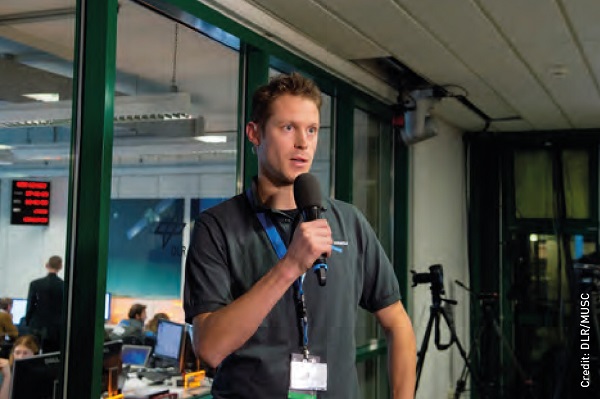 Lander Technical Manager Koen Geurts conducting a briefing for the general public on the latest Philae status during the bounce.
Lander Technical Manager Koen Geurts conducting a briefing for the general public on the latest Philae status during the bounce.
There were a number of approaches taken to derive the location. The CONSERT ranging measurements between Rosetta and Philae provided information on which a landing ellipse could be defined. Together with correlation of the magnetic field measurements between the ROMAP instrument on board Philae and the RPC-MAG instrument on board Rosetta a very accurate attitude of Philae could be reconstructed. The telemetry obtained during the on-comet operations, in particular power and communication data, provided further clues. From the solar panels the time of sunrise and sunset could be derived, which relates to a certain area on the comet.
Superimposing all this information confined the final landing site of Philae within an ellipse of approx. 50 meter. This area was subsequently imaged by Rosetta, but from a long distance away, therefore the resolution of the images did not allow for a direct identification of Philae. Several teams developed software algorithms that tried to detect Philae in the images but, to date, these have not been successful.
…the predicted last communications slot late in the evening of Friday the 15th did not occur as expected…
Now, Rosetta will not approach the comet very closely for the rest of the year, therefore, a detailed search campaign is only expected to be undertaken during the mission extension in 2016.
Of course, we are confident and hope to hear from Philae long before that and even conduct further scientific measurements. As we move towards perihelion, our closest approach to the Sun in August, the chances are increasing every day.
But regardless of what happens next, no one who was there will forgot that amazing week, especially the landing. It was space history being made.





